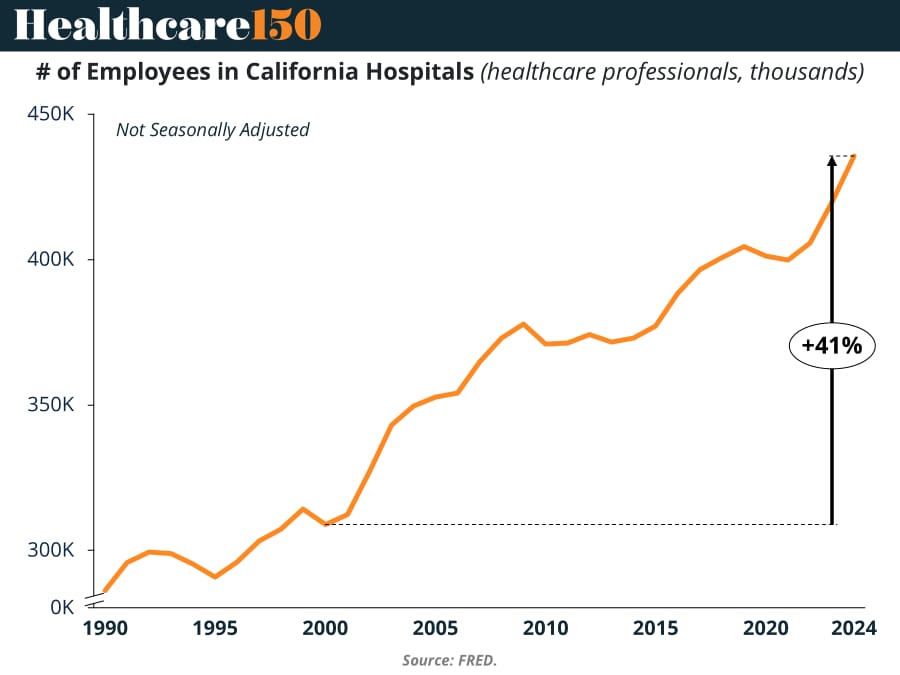- Healthcare 150
- Posts
- Golden State, Golden Paychecks? Depends on Who You Ask
Golden State, Golden Paychecks? Depends on Who You Ask
California’s Healthcare Workforce: Growth, Pay, and the Road Ahead.

California’s Healthcare Workforce: Growth, Pay, and the Road Ahead
California’s healthcare system is among the most expansive and dynamic in the United States, employing over 435,000 professionals in hospitals alone as of 2024. Over the past three decades, the state has experienced a substantial and steady increase in hospital employment, rising from approximately 286,000 employees in 1990 to today’s record levels. This growth reflects both the increasing demand for healthcare services and California’s commitment to expanding access to care.
A closer look at historical employment data from the Federal Reserve (FRED) shows a sharp acceleration in hiring beginning in the early 2000s, with notable upticks around 2003 and again from 2016 onward, totalizing a 21st century growth of +41%.
While there were brief periods of stagnation, such as between 2009–2013, employment quickly rebounded and surged dramatically post-2021. This growth trend indicates not only greater demand for healthcare services but also a broader reliance on skilled healthcare labor amid an aging population, pandemic-driven stress, and system-wide expansions.

Yet while employment numbers are climbing, wage dynamics are evolving as well. California leads the nation in nurse compensation, with registered nurses (RNs) earning an average of $124,000 annually—nearly 50% above the national mean. However, when adjusted for the high cost of living, the effective value of that salary drops closer to $106,500. Nurse practitioners (NPs) and advanced practice providers fare similarly, averaging upwards of $128,000 to $200,000, depending on specialization and experience. Still, disparities remain pronounced between regions and job functions.
For instance, entry-level and support workers—such as medical assistants, CNAs, and home health aides—historically earned much lower wages. According to recent data, healthcare support roles in California average between $18.50 to $26.50 per hour, with annual salaries ranging from $38,000 to $55,000. Recognizing these disparities, California passed Senate Bill 525 (SB 525) in 2023 to introduce a phased healthcare-specific minimum wage.
Beginning October 2024, the minimum wage for healthcare workers in large systems, dialysis clinics, and urban counties will rise to $23 per hour, increasing to $24 by mid-2025 and $25 by mid-2026. Safety-net and rural hospitals will begin at $18 per hour, gradually increasing to $25 by 2033. Over 426,000 workers are expected to benefit from the bill, with first-year raises averaging $6,400—an impactful 19% wage increase.
These changes aim to stabilize a workforce strained by burnout, high turnover, and rising living costs. For a sector grappling with staffing shortages and future demand projections, wage equity and labor support are not just economic issues—they are foundational to healthcare delivery.
In conclusion, California’s healthcare workforce is growing in both scale and policy attention. Employment has surged past 435,000 hospital staff, and legislative efforts like SB 525 are addressing longstanding wage inequities. With competitive salaries for licensed professionals and new protections for lower-wage roles, the state is shaping a more sustainable and resilient healthcare labor market—one equipped to meet the future head-on.
Sources & References
CDF Labor Law. (2024). New Minimum Wage for California Health Care Workers Takes Effect October 16, 2024. https://www.cdflaborlaw.com/blog/new-minimum-wage-for-california-health-care-workers-takes-effect-october-16-2024
Sheppard Mullin. (2024). California’s Minimum Wage Increase for Health Care Workers is on the Horizon. https://www.sheppardhealthlaw.com/2024/05/articles/healthcare/californias-minimum-wage-increase-for-health-care-workers-is-on-the-horizon/
UC Berkley. (2024). California health care minimum wage: New estimates for impacts on workers, patients, and the state budget. https://laborcenter.berkeley.edu/ca-health-care-minimum-wage-new-estimates-feb2024/
U.S. Bureau of Labor Statistics and Federal Reserve Bank of St. Louis, All Employees: Health Care: Hospitals in California [SMU06000006562200001A], retrieved from FRED, Federal Reserve Bank of St. Louis; https://fred.stlouisfed.org/series/SMU06000006562200001A, July 29, 2025.